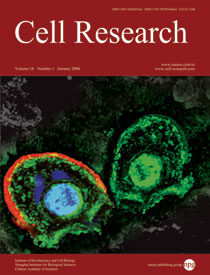
Volume 16, No 1, Jan 2006
ISSN: 1001-0602
EISSN: 1748-7838 2018
impact factor 17.848*
(Clarivate Analytics, 2019)
Volume 16 Issue 1, January 2006: 99-105
ORIGINAL ARTICLES
Gene silencing in Xenopuslaevis by DNA vector-based RNA interference and transgenesis
Ming Li1, Baerbel Rohrer1, 2
Departments of 1Neurosciences and 2Ophthalmology, Division of Research, Medical University of South Carolina, 167 Ashley Ave, SEI 511, Charleston, SC 29425, USA
Correspondence: Baerbel Rohrer(rohrer@musc.edu)
A vector-based RNAi expression system was developed using the Xenopus tropicalis U6 promoter, which transcribes small RNA genes by RNA polymerase III. The system was first validated in a Xenopus laevis cell line, designing a short hairpin DNA specific for the GFP gene. Co-transfection of the vector-based RNAi and the GFP gene into Xenopus XR1 cells significantly decreased the number of GFP-expressing cells and overall GFP fluorescence. Vector-based RNAi was subsequently validated in GFP transgenic Xenopus embryos. Sperm nuclei from GFP transgenic males and RNAi con-struct-incubated-sperm nuclei were used for fertilization, respectively. GFP mRNA and protein were reduced by ~60% by RNAi in these transgenic embryos compared with the control. This transgene-driven RNAi is specific and stable in inhibiting GFP expression in the Xenopus laevis transgenic line. Gene silencing by vector-based RNAi and Xenopus transgenesis may provide an alternative for ‘repression of gene function’ studies in vertebrate model systems.
Cell Research (2006) 16:99-105. doi:10.1038/sj.cr.7310013; published online 16 January 2006
FULL TEXT | PDF
Browse 1944


